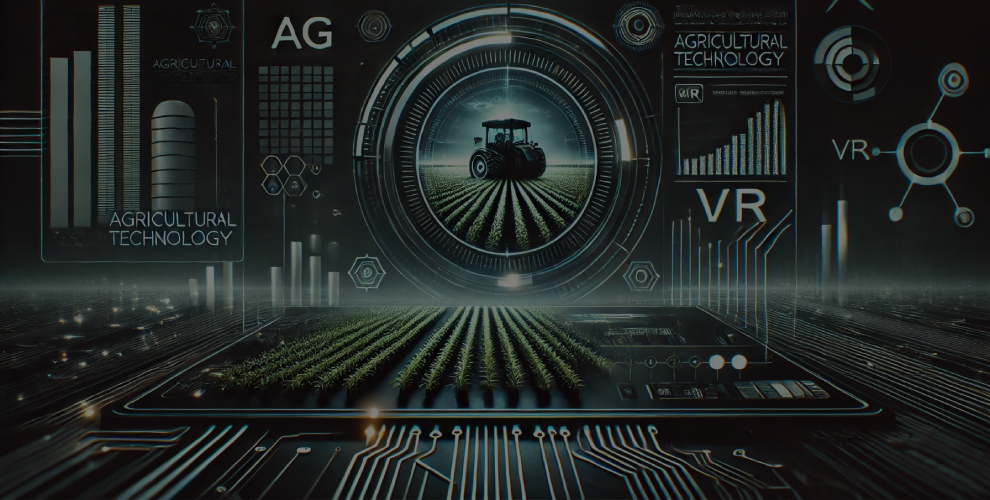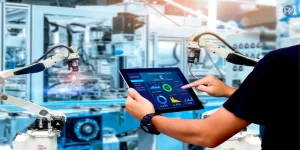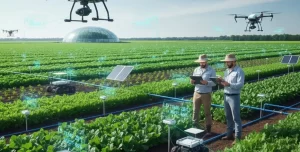
AG in VR: How Agricultural Technology is Benefiting from Virtual Reality
Table of Contents
Introduction
Welcome to WikiGlitz! Augmented Reality (AR) and Virtual Reality (VR) are no longer confined to gaming and entertainment; they are making significant strides in transforming various industries, including agriculture.
In this comprehensive guide, we’ll explore how VR technology is being integrated into agricultural practices to enhance training, simulations, and crop management. Join us as we delve into the innovative ways VR is revolutionizing agriculture.
Key Takeaways
- Enhanced Interactions:
- VR enables the seamless integration of digital elements with the real world, enhancing user interactions and experiences across various agricultural applications.
- Wide Range of Applications:
- VR is used in multiple agricultural sectors, including training, crop management, and equipment maintenance, providing innovative solutions and improving efficiency.
- Future Potential:
- With advancements in technology, VR frameworks are set to become even more sophisticated, offering new possibilities for both consumers and businesses in the agricultural industry.
Understanding VR in Agriculture
Definition and Explanation
Virtual Reality (VR) is a technology that creates a simulated environment using computer-generated imagery and sounds, allowing users to experience and interact with a 3D world that mimics or differs from the real world.
By wearing a VR headset, users can immerse themselves in these digital landscapes, experiencing sights and sounds as if they were physically present in that environment.
Overview of VR in Agriculture
In agriculture, VR is being integrated to enhance various aspects of farming. From training new farmers and monitoring crop health to planning and decision-making, VR offers a range of applications that improve efficiency and accuracy.
The immersive nature of VR allows farmers to visualize data and processes in ways that were previously not possible, leading to better-informed decisions and optimized farming practices.
Training and Education
How VR is Used for Training New Farmers and Agricultural Students
Virtual Reality (VR) is revolutionizing training in agriculture by providing immersive and interactive learning experiences. Traditional training methods often involve classroom lectures or hands-on training in the field, which can be costly and time-consuming. VR offers an alternative by simulating real-world farming scenarios in a controlled, virtual environment.
Benefits of VR Training Programs
- Cost-Effective:
- VR training reduces the need for physical resources and travel, lowering overall training costs.
- Risk-Free:
- Trainees can practice potentially dangerous tasks, such as operating heavy machinery, without any real-world risks.
- Immersive:
- VR provides a realistic, engaging experience that helps trainees retain information better than traditional methods.
Crop Management and Monitoring
Use of VR for Crop Monitoring and Management
VR technology enables farmers to monitor and manage their crops more effectively. By using VR headsets and compatible software, farmers can visualize their fields in 3D, assess crop health, and identify issues such as pest infestations or nutrient deficiencies.
Advantages of VR in Crop Management
- Detecting Crop Health:
- VR can overlay real-time data on crop health, allowing farmers to quickly identify and address problems.
- Pest Infestations:
- Early detection of pests is crucial for maintaining healthy crops. VR can highlight affected areas, making it easier to implement targeted treatments.
- Optimal Harvest Times:
- By visualizing crop growth stages in VR, farmers can determine the best time to harvest, ensuring maximum yield and quality.
Simulations for Planning and Decision-Making
How VR Simulations Help Farmers Make Informed Decisions
VR simulations provide farmers with a powerful tool for planning and decision-making. By simulating various farming scenarios, farmers can test different strategies and see the potential outcomes before implementing them in the real world.
Examples of VR Simulations
- Weather Forecasting:
- VR simulations can incorporate weather data to predict how different weather conditions will impact crops, helping farmers plan accordingly.
- Crop Yield Predictions:
- Farmers can use VR to simulate different planting schedules and crop varieties, predicting potential yields and choosing the best options for their fields.
- Soil Analysis:
- VR can visualize soil composition and fertility, helping farmers select the right fertilizers and optimize soil health.
Equipment Training and Maintenance
VR for Training on Agricultural Equipment Operation and Maintenance
Operating agricultural machinery requires skill and precision. Virtual Reality (VR) offers an innovative solution for training individuals on the operation and maintenance of agricultural equipment. By using VR simulations, trainees can learn how to operate complex machinery without the risk of damage or injury.
Benefits of VR in Reducing Downtime and Improving Safety
- Reducing Downtime:
- VR training allows operators to practice and perfect their skills, reducing the likelihood of mistakes that could cause equipment breakdowns and downtime.
- Improving Safety:
- Training in a virtual environment eliminates the risk of accidents, ensuring that operators are fully prepared to handle machinery safely in real-world conditions.
Enhancing Precision Agriculture
Integration of VR with Precision Agriculture Technologies
Precision agriculture involves using technology to monitor and manage variability in crops, optimizing inputs like water, fertilizer, and pesticides to enhance productivity and efficiency. VR can be integrated with precision agriculture tools to provide detailed visualizations of data collected from fields.
How VR Improves Accuracy in Planting, Irrigation, and Fertilization
- Planting:
- VR can simulate planting scenarios, helping farmers determine the best planting patterns and densities to maximize yield.
- Irrigation:
- By visualizing moisture levels in the soil, VR can assist farmers in designing efficient irrigation systems that conserve water and ensure optimal crop hydration.
- Fertilization:
- VR can display nutrient levels in the soil, allowing farmers to apply fertilizers precisely where needed, reducing waste and enhancing crop health.
Case Studies and Real-World Examples
Highlight Successful Case Studies of VR in Agriculture
- Case Study 1: John Deere’s VR Training Program:
- John Deere has implemented VR training programs to educate their employees and customers on the operation and maintenance of their equipment. This has resulted in reduced training costs and improved safety records.
- Case Study 2: VR in Vineyard Management:
- A vineyard in California uses VR to monitor grapevines’ health and manage pest control. The technology has helped increase grape yield and reduce pesticide usage.
Real-World Examples of VR Applications in Farming
- Example 1: Precision Hawk’s VR Crop Monitoring:
- Precision Hawk uses VR to provide farmers with a detailed, 3D view of their fields, helping them identify crop health issues and make informed management decisions.
- Example 2: VR in Dairy Farming:
- VR is being used in dairy farms to monitor cow health and manage feeding schedules. Farmers can virtually tour their facilities and observe their livestock, ensuring optimal care and productivity.
Challenges and Limitations
Discussion of the Challenges Faced in Integrating VR in Agriculture
Despite the numerous benefits VR brings to agriculture, some several challenges and limitations need to be addressed.
- Technical Challenges:
- Implementing VR technology requires advanced hardware and software, which can be complex to set up and maintain. Ensuring compatibility with existing agricultural systems and tools can also be a challenge.
- Financial Barriers:
- The initial cost of VR equipment and software can be high, making it a significant investment for farmers, especially those with smaller operations.
- Adoption Barriers:
- There can be resistance to adopting new technologies among farmers, particularly those who are more accustomed to traditional farming methods. Training and education are necessary to demonstrate the benefits and ease of use of VR.
Future Trends in VR for Agriculture
Emerging Trends and Innovations in VR for Agriculture
The future of VR in agriculture looks promising, with several emerging trends and innovations set to further enhance its applications.
- Advancements in Hardware:
- Future VR devices are expected to be lighter, more powerful, and more affordable. Improvements in display technology, battery life, and processing power will enhance the user experience and broaden the applications of VR in agriculture.
- Integration with AI:
- Artificial intelligence (AI) will play a significant role in the evolution of VR, enabling more sophisticated object recognition, contextual understanding, and user interaction. AI-driven VR applications will offer more personalized and intuitive experiences for farmers.
- Expansion into New Areas:
- VR is set to expand into new sectors within agriculture, such as precision livestock farming and vertical farming. These applications will help optimize animal health and productivity, as well as maximize crop yields in controlled environments.
Conclusion
WikiGlitz has brought you this comprehensive guide to understanding how VR is transforming agricultural practices. From training and education to crop management and precision agriculture, VR offers numerous benefits that enhance efficiency, accuracy, and productivity in farming.
As technology continues to advance, the potential for VR to revolutionize agriculture grows, offering new possibilities for farmers worldwide. Stay tuned to WikiGlitz for more insights into the fascinating world of virtual reality and its impact on various industries.
FAQs
What is VR and how is it used in agriculture?
Virtual Reality (VR) is a technology that creates a simulated environment using computer-generated imagery and sounds. In agriculture, VR is used for training, crop management, equipment maintenance, and precision farming, enhancing efficiency and accuracy.
What are the benefits of using VR for training in agriculture?
VR training programs are cost-effective, risk-free, and immersive. They allow trainees to practice tasks in a virtual environment, reducing the risk of accidents and improving skill retention.
How does VR help in crop management and monitoring?
VR enables farmers to visualize their fields in 3D, assess crop health, and identify issues such as pest infestations or nutrient deficiencies. This helps in making informed decisions and optimizing crop management practices.
What are some real-world examples of VR in agriculture?
Examples include John Deere’s VR training program for equipment operation, Precision Hawk’s VR crop monitoring, and the use of VR in dairy farming to monitor cow health and manage feeding schedules.
What challenges do farmers face in adopting VR technology?
Challenges include the high initial cost of VR equipment and software, technical complexities in setting up and maintaining VR systems, and resistance to adopting new technologies among farmers accustomed to traditional methods.
Want to keep up with our blog?
Our most valuable tips right inside your inbox, once per month.
Error: Contact form not found.
WikiGlitz Team
Welcome to WikiGlitz, your ultimate destination for tech insights and innovation. Our expert team is dedicated to delivering free resources and professional advice on various technology topics, including Artificial Intelligence, Cyber Security, Cloud Computing, and more. We strive to empower our readers with up-to-date information and practical guidance, ensuring you stay ahead in the rapidly evolving tech landscape. At WikiGlitz, we are passionate about making complex technology accessible to everyone. Our team of seasoned experts curates content that is both informative and engaging, helping you understand and leverage the latest tech trends. Whether you're a tech enthusiast or a professional, WikiGlitz is your go-to source for reliable, expert-driven content. Join us on this journey to explore and embrace the future of technology.





